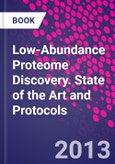Low-Abundance Proteome Discovery addresses the most critical challenge in biomarker discovery and progress: the identification of low-abundance proteins. The book describes an original strategy developed by the authors that permits the detection of protein species typically found in very low abundance and that may yield valuable clues to future discoveries. Known as combinatorial peptide ligand libraries, these new methodologies are one of the hottest topics related to the study of proteomics and have applications in medical diagnostics, food quality, and plant analysis. The book is written for university and industry scientists starting proteomic studies of complex matrices (e.g., biological fluids, biopsies, recalcitrant plant tissues, foodstuff, and beverage analysis), researchers doing wet chemistry, and graduate-level students in the areas of analytical and biochemistry, biology, and genetics.
Please Note: This is an On Demand product, delivery may take up to 11 working days after payment has been received.
Table of Contents
Antiphon 1. Introducing low-abundance species in proteome analysis 2. Chromatographic and electrophoretic pre-fractionation tools in proteome analysis 3. Current low-abundance protein access 4. Low-abundance protein access by combinatorial peptide libraries 5. Plant proteomics and food and beverage analysis via CPLL capture 6. Biomedical involvements of low-abundance proteins 7. Other applications of combinatorial peptide libraries 8. Detailed methodologies and protocols Polyphony








